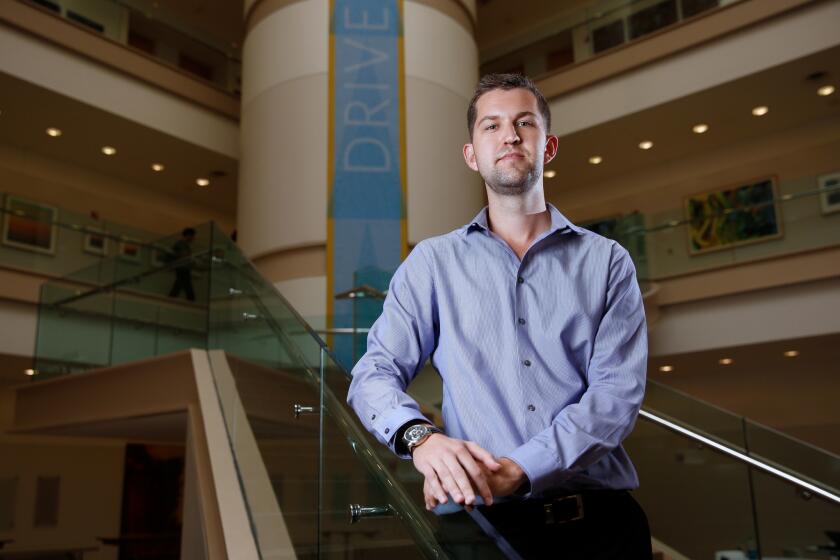Price of an OCD drug jumped 1,200%. State attorneys general blame price fixing
Her patient’s voice was panic-stricken, Emily Deans said, and her story was baffling.
“She said, ‘I can’t fill my prescription, it’s too expensive,’” said Deans, a psychiatrist near Boston, recalling a conversation from about five years ago. A patient who suffered from severe obsessive-compulsive disorder called, upset that she could no longer afford her medication, a drug called clomipramine. The price of a month’s supply had suddenly jumped from $16 to $348.
The increase appeared to defy logic. “This is crazy for a generic drug that’s been around for decades,” Deans said. Clomipramine was discovered 55 years ago; it was approved to treat OCD in 1989 and became available in cheap, generic form in 1996. Why the sudden price hike?
A possible answer finally came this year.
In May, attorneys general in more than 40 states accused three pharmaceutical companies that make clomipramine — Taro Pharmaceuticals Industries Ltd., Mylan Pharmaceuticals Inc. and Novartis AG’s generics arm, Sandoz — of conspiring to raise the drug’s price. The allegation is part of a sweeping lawsuit that names 20 generic drugmakers and subsidiaries in all, as well as 15 current and former industry executives. It says they communicated with one another to fix prices and divvy up customers for more than 100 drugs, treating a range of maladies, including HIV, high blood pressure and fungal infections.
The companies, including those that make clomipramine, have denied the states’ allegations. Nonetheless, the lawsuit, along with a similar one filed in 2016 and a federal investigation into price-fixing allegations, have rocked the generic drug industry, long regarded as consumers’ haven from the spiraling prices of name-brand medicines.
“We were seriously looking at dog clomipramine for a patient of mine with OCD. You start thinking, ‘Do I know a vet?’”
— Emily Deans, psychiatrist
Decrying “one of the most egregious and damaging price-fixing conspiracies” in U.S. history, the lawsuit alleges that generic drugmakers illegally heaped billions of dollars of costs onto patients, employers and taxpayers. During the peak of the alleged conspiracy from 2013 to 2015, drug companies quadrupled the price of baclofen, which treats muscle spasms caused by conditions such as multiple sclerosis. They raised the price of a bladder-condition drug, oxybutynin chloride, by more than 1,000%. They took the price of an arthritis medication, etodolac, at least 200% higher.
Few drugs saw sharper price hikes than clomipramine, which weakens the powerful compulsions that cause OCD sufferers to spend hours each day stuck in rituals, like washing their hands or checking the locks and windows in their houses. It’s one of only five medications that U.S. regulators have approved for OCD, so clomipramine’s price hikes roiled patients’ treatment plans nationwide. (An estimated 1.2% of U.S. adults had OCD in the last year, and about half those cases were classified as “serious.”)
Horizon Pharma charges more than $2,000 for a month’s supply of a prescription pain reliever that is the combination of two cheap drugs available separately over the counter.
The first jolt came on May 1, 2013, when Taro’s U.S. unit raised its price from 85 cents to $11.24 per dose — more than 1,200% — according to data from Connecture Inc., a healthcare technology company. In a competitive market, other companies would be expected to try to beat that price to lure customers away from Taro. But that didn’t happen.
Instead, according to the lawsuit, executives for Taro were in close communication with their counterparts at Mylan and Sandoz. At least 26 phone calls took place among the three companies’ sales executives in the four weeks before Taro’s price increase, the lawsuit claims. “During these conversations, defendants Taro, Sandoz and Mylan agreed to raise the price of clomipramine,” the states’ complaint says.
Within weeks, Mylan and Sandoz raised their own prices from less than $1 per dose to $11.24 per dose — identical to Taro’s price — according to Connecture’s data.
Instead of competing for market share, the drugmakers worried about being too aggressive, according to the lawsuit, and instead agreed to divvy up certain customers. In August 2013, Walgreens drugstores, a Mylan customer, asked Sandoz to bid for supplying clomipramine. But a Sandoz sales executive shot the idea down, saying in an internal email, “that is tempting but I worry very disruptive,” according to the lawsuit.
A Mylan spokeswoman said in an emailed statement that company officials have “investigated thoroughly and have not found evidence of price fixing on the part of Mylan or its employees.” The newer civil case “consists of unproven allegations” that the company believes “will prove meritless when examined in the court of law,” the spokeswoman said. A spokesman for Novartis, which owns Sandoz, said the company believes the “cases are without merit, and we will vigorously contest them.” Taro didn’t respond to requests for comment.
Clomipramine’s new price has meant fatter revenue for its makers. Mylan, for instance, has generated an additional $422 million in sales just from the increase, according to a report by investment bank SVB Leerink LLC.
U.S. taxpayers have paid some of that cost. Medicare, the government-funded program that covers prescription drugs for some 43 million Americans, spent between $3 million and $4 million a year on clomipramine from 2010 to 2012, no more than 40 cents per dose. But since the 2013 price hikes, Medicare has spent about $77 million a year on the drug, at $7.42 per dose.
OCD drugs work only about half the time, and patients often have to try two or three of them. Clomipramine is the oldest of the drugs and it causes stronger side effects, like dry mouth and constipation. But it’s also one of the most effective.
At least eight pharmaceutical companies sell a decades-old drug that treats gallstones, but the competition has done little to keep its price down.
“It can be a life-changing medication,” says Jason Garvin, a psychiatrist with the Houston OCD Program, which provides residential and outpatient care. Clomipramine’s new price has put it out of reach for a number of Garvin’s patients, particularly those without insurance. A couple of them tried to import it from Canada while others have run out of options, he says. “They just don’t get the medicine and they continue to suffer.”
Some have pondered desperate measures. Deans, the Boston-area psychiatrist, noticed that an identical version of clomipramine was being sold to veterinarians for use on dogs at about a quarter of the cost. “We were seriously looking at dog clomipramine for a patient of mine with OCD,” Deans tweeted last year.
“You start thinking, ‘Do I know a vet?’” she said in an interview. “It’s fraud, so obviously, you can’t do it. But this person really needs her medication. It’s all ridiculous.”
Cheryl Slavin, 41, began taking clomipramine a decade ago, after she was hospitalized for a nervous breakdown stemming from her struggles with OCD and bipolar disorder. Slavin, who lives in Boise, Idaho, had first shown OCD symptoms at age 5, when she would constantly wash her hands. Over time, her symptoms became more severe: time-consuming rituals and intrusive, disturbing thoughts that she couldn’t control. Her attempts to ease her condition through exercise and diet didn’t seem to help.
“The drug was not only a total lifesaver, it caused a total transformation for me,” she says. “I wasn’t a slave to my thoughts anymore.” But a year ago, after she took a job in a call center captioning telephone calls for the deaf, she switched to her new employer’s health insurance plan. Instead of the monthly $25 copayment she’d previously paid for clomipramine, her new insurer required $100 a month.
She struggled with the additional cost and eventually fell into debt. She also was experiencing some side effects, she says, so three months ago, she and her doctor decided to make a terrifying switch to a new drug. “I felt like I couldn’t live without it,” she says. “I thought I would end up back in the hospital.”
The transition has been grueling. She and her doctor have struggled to balance her new medications, and Slavin has experienced a debilitating spike in anxiety and paranoia. She recently had to take a leave of absence from her new job. Slavin says she’d like to go back on clomipramine, but just can’t afford it.
Slavin still fumes about clomipramine’s dramatic price increase, which she says drugmakers seemed to impose without much thought about the consequences for people like her.
“It’s inexcusable,” she says. “It shows an extreme lack of compassion for someone with a mental illness.”
More to Read
Inside the business of entertainment
The Wide Shot brings you news, analysis and insights on everything from streaming wars to production — and what it all means for the future.
You may occasionally receive promotional content from the Los Angeles Times.











